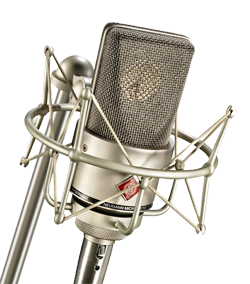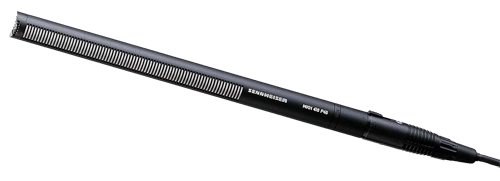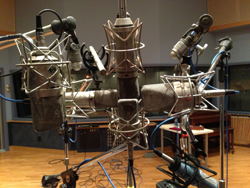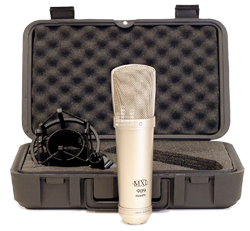 Q It Up: What mic(s) do you use for your voiceover work? What are your likes and dislikes about the mic(s)? If you had your choice of ANY mic, what would you choose and why? What pre-amp(s) do you use? Feel free to add any other related comments and thanks for your feedback!
Q It Up: What mic(s) do you use for your voiceover work? What are your likes and dislikes about the mic(s)? If you had your choice of ANY mic, what would you choose and why? What pre-amp(s) do you use? Feel free to add any other related comments and thanks for your feedback!
 Mitch Todd, SiriusXM: I fell in love with the Neumann TLM-103 when it first came out and I haven’t gone back (to the U-87). The Sennheiser MKH-416 is in my bag of video mics and will occasionally pull that out if I want to really “cut” and/or am in a noisy environment. If recording someone’s vocal for something critical, I’ll use the UA 6176 channel strip, but prefer the sound of the DBX 376 WITH UPGRADED TUBE!
Mitch Todd, SiriusXM: I fell in love with the Neumann TLM-103 when it first came out and I haven’t gone back (to the U-87). The Sennheiser MKH-416 is in my bag of video mics and will occasionally pull that out if I want to really “cut” and/or am in a noisy environment. If recording someone’s vocal for something critical, I’ll use the UA 6176 channel strip, but prefer the sound of the DBX 376 WITH UPGRADED TUBE!
Dave Cox, www.2dogsdigital.com, Moline, IL: Mic selection for us is dependent on two factors: voice talent and end-use, but for this we'll just talk broadcast.
We use a Neumann U47fet for the guys with aggressive input to the mic. There's an old Sennheiser 415T shotgun if you wanna go Don LaFontaine. Female talent often get the AKG 441's -- it's sweeter on the upper mid's… look out for 8k however. Our go to mic is the forgotten EV RE-3000, no-noise… really, and it's smooth and natural across the spectrum.
Everything runs into tube pre-amps. The Avalon VT-737sp gets the most work. It has 1948 Dutch made NOS tubes. It's typically set to knock down a couple of db with a 3.2x1 ratio. For more color we have an old TL Audio Dual valve pre/comp. It has 1948 Telefunken NOS tubes currently. There's an old Focusrite solid state pre for clean.

Jeff Augustine, www.jeffaugustinevo.com, Cape Girardeau, MO: I currently use the Sennheiser 416. It's a great mic for just about all the VO work I do. What I like most is just the clean, true sound it delivers with each read. The only bad thing I can say about it, and it really isn't a complaint as much as it is operator technique, you have to be able to know how to "work" the mic to obtain the best read for whatever project you're voicing. Other than that, it's a stellar and classic beast!!
For the pre, I have an oldie but a goodie (at least in my opinion) with the Focusrite Voice Master Pro. I've had it for quite a while, and although I really don't use anything on the strip other than the gate, it's been a solid piece of equipment for me. The rest of my chain is pretty simple: the Focusrite goes into the Focusrite Saffire DSP 24 Pro, which all goes into my iMac running AA CS6. Thanks!
Doug de Nance, www.dougdenance.com, Calgary, AB: I use a 416 exclusively. Find that it seems to fit my voice well (I do use some processing a touch of compression, EQ and de-ess if the client doesn¹t want dry files). If you have a listen to my latest narration demo on my website http://www.dougdenance.com, everything on it was recorded with the 416. I actually have two, one permanently in my booth and one for travel (I do a lot of live announcing gigs so I’m on the road quite a bit). The 416 is pretty rugged (even though I pack it in a Pelican case with my other gear). And it rejects a lot of room noise as well. So by using the same mic, plugins etc. when I¹m on the road, my hope is that I can provide as much consistency for the clients as possible.
Jim Harvill, iHeartMedia NWA, Fayetteville, AR: We're (myself included) big fans of ElectroVoice RE 27-ND. They're in all of our control and prod rooms.
Craig Jackman, Loyalist College, Belleville, ON: For most voices in studio I want the mic to not color the voice excessively, but will allow good voices to experiment with proximity effect for a pleasing tone change. The Rode NT2 was particularly neutral, and I had some voices really like it. We had a Neumann U87 for a while, but we had to get rid of it as it was so sensitive to temperature and humidity changes. For most of my studio life I used a Beyerdynamic MC740, which is the best mic over time that I’ve ever used. I really like large diaphragm condensers, and have never had great success using something like and RE20 or SM7 in the studio. For some reason, lots of radio people really like them, but I could never get a really nice sound out of them. They are durable and don’t require phantom power, but I just don’t like how they sound.
Then there are mics for flattery. I swear I am the only person I know who sounds good on a Microtec Geffall PM860, so that’s what I have in my studio right now. Sounds like crap on everyone else, but I sound great on it. It just fits!
The most interesting mic I’ve ever used was an AKG SolidTube mic. Discontinued now, but when we plugged it in and turned it on it just sounded amazing! I’ve always wanted a tube mic ever since.
The pre is the Focusrite Scarlett 2i2.
Tim Denniston, LeSEA Broadcasting, South Bend, IN: I have been EXTREMELY happy with the Blue Mouse for voiceover. It has great response and sounds incredibly smooth. It looks cool, too.
Gary Michaels, WASK-AM, Lafayette, IN: I typically use three different industrial strength mics for voice work. A) The classic EV RE-20 through a PreSonus TubePre. I've traded out the stock tube for a classic Mullard tube, and with a little tube gain it gives me a pretty sweet tone. B) A Shure KSM27. Not a lot of bucks for a great transparent condenser mic with good proximity effect. Just add a pop screen and you've got an extremely versatile mic. For clients I traditionally use a Shure SM57. Great dynamic mic with no coloration. I can add anything in post I want. There you go… simple mics for a simple guy.
I run all my studio mics through the PreSonus TubePre preamp. It's a simple preamp with phantom power, simple gain and a tube stage. Very quiet preamp for the money though the stock tube was a bit crispy with very little overhead. I bought a vintage NOS Mullard tube, and given about 30 minutes to warm up, it delivers some nice toast if I turn up the tube gain... usually about 50% with this preamp.
Dave Savage, iHeartMedia Creative Services Group, Atlanta, GA: I like a good cardioid mic if you have a completely dead room, but I don’t. My voice work is in the closet – literally, so I like the directional pattern of the Sennheiser MKH 416. It’s pretty good at not picking up all the room tone without compromising vocal tone. I use it with a Scarlett 2i2 USB interface, so it all fits in my laptop bag for a convenient piece of carry-on, and I can voice from a hotel room or just about anywhere.
Eric Millham Dr. James A. Forrest Career & Technology Center, Leonardtown, MD: My students and I use a Shure SM7 for our voiceover work. Due to budget constraints, at this time we are running it directly into the mixer and aren't running it through a pre-amp. We hope to change that situation next school year.
Rafe Sampson, Sampson Media, Inc., Morris, IL: In this business, clean sound is king. I have been primarily using a CAD e100s for about a year now. It has the lowest self-noise of any LDC mic, and a tight super-cardioid pattern. Takes a while to find the ‘sweet spot’ but it’s a real clean sound. Could probably be overly sibilant for some voices, perhaps. It can be hard to do some reads, at least for me, because I tend to move around a lot and flail my arms and such. Also still love my Rode NT2 (the old model, not the NT2a). It’s a very full sounding large condenser, with just a bit more low-mid and bottom sound than the CAD. Gives me a real rich, full sound. I’m usually using its cardioid pickup pattern, but if I have to get loud, the omnidirectional option is nice to have. Still have my Shure SM-7 and, though I haven’t used it in years, an EV RE-20. Hanging on to the radio memories I guess.
My pre is a UA Twinfinity 710. Love the fact that I can dial in as much tube as I want, should I want tube. Real clean sounding pre with a ton of gain. I use the low-cut on the preamp as opposed to the mics -- seems to be far less noise. I still have the pre that the UA replaced, which is a Digidesign VTP-1 (probably 18 years old). I think it needs a new tube, but that old girl is just awesome with the condenser mics. Everything runs through a Focusrite Saffire 6, which has preamps that I don’t utilize. Just use it for AD/DA conversion and the USB connection.
My choice of any mic… hmmmm. There’s so freaking many out there! I’m pretty happy with what I have (and none are budget breakers, for sure). But I’d like to hear what I sound like thru the LA scene’s favorite, the Sennheiser 416 shotgun, running through a Manley VoxBox. Maybe my hearing is whacked, but when I hear A/B tests of some of the four and five figure mics (especially Neumann), I just don’t hear enough difference to warrant investing so much. Technology has made quality microphones much more affordable.
FYI… next potential upgrade I’m looking at is the Audient id-22. Heard nothing but raves about the preamps in this interface.
Steve Mitchell, Indy Voice Productions, Amherst, NY: What mic(s) do you use for your voiceover work?
It all depends on the talent -- male or female. I have found for the few women voicers who come through here, I use any RCA 77D series in the 'music 1' position and in the cardioid setting - keeping them at least 8 inches away from the mic, with a blast screen. For most guys, any condenser. Right now, one of my faves in The Gauge ECM 87. I personally use the MXL V69. I run all mics through one of my Behringer Ultra Voice Digital pre-amps without any coloration - I always record flat.
What are your likes and dislikes about the mic(s)? I love 'em all for different reasons.
If you had your choice of ANY mic, what would you choose and why? My all-time favorite mic to use is the AKG C12 VR, but who can afford $7,000.00 for one mic???
I don't use a board anymore. Everything goes through a digital interface, either a Tascam US 2000, or a Focusrite Scarlett 18i8 - depending on the system I'm using.
I choose my Bock after doing a mic showdown by ordering 5 mics from Sweetwater and doing an A-B test with a common script and listening to feedback from respected, professional ears. They compared each mp3 I sent them as 1 thru 5 without telling them what mic was which file. That “Blind Taste Test” yielded good enough results that showed which mic worked best with my individual tone and timbre. I choose the Bock Audio 195 and have been very happy since. I sent back the other 4 mics for a full refund within 30 days by Sweetwater. Great company.
My Bock favors my tenor voice and allows the natural base of my voice to come through in a clean manner and not muffled, as some mics sounded to me during the test. Great high end without silence and ability to thicken it up with the available fine tuning on the mic. Additionally, I got my 416 due to a deal -- I couldn’t pass it up last Spring -- for other project applications. Definitively the mic of choice by many.
Andy Berkowitz, Forever Media, Altoona, PA: At work, I use AKG Perception 200 mics, and at home, I use its recently released cousin, the AKG P220. In my opinion, these are the absolute best condenser mics for the money. They’re solidly constructed, and you get rich, gorgeous vocals... bass roll-off, and a -10db pad if you need it... all for about $150. Plus, they look great too, so clients do get a little eye candy when they record in the studio. They’re sensitive enough for you to play with the proximity effect when you want that booming voice of power, but they’re versatile enough to work with every voice or character you’ve got. Are there better condensers out there? Sure, but they’re nowhere near this price point, and quite frankly, these mics do sound as good, or better than some models that cost a lot more. The bottom line is that the AKG Perception 200 and AKG P220 deliver sound you’ll love, at a price your GM won’t laugh at. Now, if I had an unlimited budget, I will confess a soft spot for the classic ElectroVoice RE20. It’s the best sounding dynamic mic I’ve ever touched. It just makes everyone sound seven-feet tall and super powered. As for pre-amps, at work we use our tried and true Symetrix. At home, I’m on more of a shoestring, so I use a Focusrite Scarlett 2i2 Audio Interface, which has a pretty great sounding preamp built in. You actually can’t tell the difference between the vocals I record at home or at the station.
Walter Wawro, WFAA-TV Channel 8, Dallas, TX: This is the WRONG question to ask me since I collect microphones. So yes, I have several of the true classics with numbers you know (47, 77, 84, 414 etc.).
But here's my current combo and why I'm very happy with it. I'm a long time Pro Tools user, and while I'm on PT 10.9 HD Omni, I still use the original 192 boxes. Part of that set up included the Digidesign "Pre" which is OK but nothing special.
Last year I replaced the "Pre" with the new Audient ASP 880 8 channel preamp. It was plug and play down to the DB25 connectors and a huge improvement in clarity and fidelity. I purchase a lot of my microphones used (why not) and was able to get a Lawson 47FET. This is an excellent boutique mic simply because it is clean and full. I don't do a lot of voice work myself, but the male and female talent who have worked the microphone all sound better than ever. I even sound decent on it! The Lawson/Audient combo gives me punch and a lot of flexibility in fitting voice into the mix. Except for the extreme low frequencies, I really don't touch the EQ.
Other condenser microphones I also like include The Audio Technica 4050, and the somewhat unique KEL HM2D, a condenser voiced to sound like a dynamic. Speaking of dynamics, I really like the Beyer M88, the Electro Voice RE 15-16-18 models (not a fan of the RE 20). I mix bands/singers for our local morning TV gab fest, and the Shure 58 and Beta 58 along with the AKG 535EB are my preferred vocal microphones.
Dave Spiker, Imagination Media, Fayetteville, GA:
I started out with the venerable Sennheiser MD421 in 1976. Still have it. Have tried several others over the years including the Sennheiser 416 - nice. My main mic now is the Neumann TLM103 using a Grace M101 preamp. But knowing that different mics sound better on certain voices, I did something I've always wanted to do. I booked an hour of studio time at Doppler Studios -- big music studio in Atlanta. They were kind enough to set up nearly every mic in the house for me for a true test of which sounded the best.
 It was great fun. Maybe a bit extreme, exorbitant and ostentatious, but fun. I was really looking forward to upgrading to the RIGHT mic. I sent blind samples of the audio from the different mics to several of my "golden ears" friends asking them which fit my voice the best. They all chose......... wait for it............ the mic I was already using: Neumann TLM103. Go figure.
It was great fun. Maybe a bit extreme, exorbitant and ostentatious, but fun. I was really looking forward to upgrading to the RIGHT mic. I sent blind samples of the audio from the different mics to several of my "golden ears" friends asking them which fit my voice the best. They all chose......... wait for it............ the mic I was already using: Neumann TLM103. Go figure.
But, I must add this. At a good friend's suggestion, I also purchased an AKG Perception 220. In that same Doppler session, we tested it against the Neumann U87. Almost identical -- just a tad more self noise. The Neumann retails for $3500. The Perception, at the time I'm writing this, is $149 at Amazon.com. And it comes with a metal case and a shock-mount. Hard to beat.
David M. Boothe, CAS, The Hope Center, Dallas, TX: For the past year and a half, our primary “go to” mics for the studios have been the MJE-v250s from Michael Joly Engineering. Other mics include several Oktava MK-012 (three of which have been modified by Michael Joly), an RE-20, a Heil PR-40, a couple of Cascade Fatheads, a Shiny Box 46MXC, and an older AKG C-414B ULS. There are also some SM-58s, and various head-worn and lavalier mics for live events and video shoots, when needed.
Primary preamps are Universal Audio Solo/610 (2 units) and an LA-610 channel strip. For the ribbons, we have “The Ribbon Preamp” (TRP) from Audio Engineering Associates. In one room, we have a Rupert Neve Portico II channel strip. When we need additional channels, we have several channels of FMR Audio’s RNP-8380.
For booming the occasional interior video shoot, we use one of the modified MK-012s feeding a either a Sound Devices MM-1 or MP-1.
For our daily live broadcast, the host uses a Countryman E6, because she moves around quite a bit. The co-host uses an MJE-v250.
Apart from our daily live broadcast, we have many different voice talent that we record, both in-house and external. Our selection of mics and preamps provides us with a wide range of suitability, adaptability to different situations and a variability in tone color.
Manufacturer links: Michael Joly Engineering MJE-v250, Michael Joly Engineering modified Oktava MK-012, Cascade Fathead, Shiny Box 46MXC, Electro-Voice RE-20, Countryman E6, Heil PR-40, Universal Audio SOLO/610, Universal Audio LA-610, AEA TRP, Rupert Neve Portico II, FMR Audio RNP-8380, Sound Devices MP-1, Sound Devices MM-1.
Heikki Wichmann, NRJ, Helsinki, Finland: For VO's and other vocals I use the Röde NTV tube microphone. I bought it back in 1998 when it was a brand new product on the market. I heard some comparisons with Neumann's high-end mics and Röde was doing so well that it was easy to make decision.
I've used different preamps and for last 8 years. I've been using the SPL Channel One. When I was changing my preamp, I tested 6 different preamps and SPL sounded best. This combination makes VO's sound clear and neutral, and they're "ready to use" so I don't need to use hard EQ to make it sound proper.
Dermot O'Neill, WCBS-FM, New York, NY: In our production rooms here at CBS-FM and Fresh 102.7 we use three different mics: the Electro Voice RE 27, the Shure SM7B and the Shure SM5B – the Shure SM5B being the best sounding hands down. For mic processing, we use the Symetrix 528E.
Jay Rose, www.JayRose.com, Brooklyn, MA: I pretty much had the choice of any v/o mic (under $2k) when I built my current booth. So I asked my dealer to send a bunch, and got together with another engineer for auditioning. I'd be in the booth while he listened, then we'd reverse places.
Funny thing happened. We'd both settled on a well-known Japanese large-diaphragm condenser as having the "best sound". But when Dan came out of the booth to talk to me, I realized what I'd been hearing from the monitors wasn't his real-world voice! The mic 'flattered' it, which was nice but also a form of distortion!
I was worried that any distortion would become fatiguing over the long-term. And that a mic which flattered our baritone voices would be harsh on some others. Since we record a wide variety of talents in that booth, I wanted to save the flattering for post-production... where it can be tweaked or undone.
We wanted reality. Flattery is the worst form of imitation.
I got the then-current top model of AKG C414. And have been very happy, ever since, using it for recordings that range from web broadcast to large theatrical trailers. If I could get ANY mic, it'd be a well maintained RCA 77DX. But I'd also keep the AKG.
The AKG talks to an ATI M-100 preamp right next to it, in the booth. I chose the ATI because it sounds good and has remote gain trimming, something necessary when you're working with a variety of talents. (We had to put the preamp in the booth because of my mistake while building the room: mic cables ran too close to a light fixture, and we installed SCR dimmers. Buzz city. Replacing the cables with star-quad wasn't practical. So we run line level to the console, keeping the wires quiet.)
 Micheal G Ziants, Airlift Productions, New Orleans, LA: While the Electro-Voice RE27 N/D has been a mainstay, go-to mic for years - with qualities that seem to marry the best of dynamic and condensers, and is especially useful with the often tricky female vocal - through the past few years Airlift and I have taken a tip from V/O guru Harlan Hogan. In his stunning read, ‘Voice Actor’s Guide to Recording at Home… and on the Road’, he gushes over the unique performance, especially given it’s remarkably cost-effective price, of the Marshall MXL-909 condenser. And of its ability to compare rather favorably in blind shoot-outs to the Sennheiser 416 shotgun! I must say that, as is so often the case with this guy, Harlan really knows what he’s talking about. My MXL-909 run through an ART (Applied Research & Technology) vocal channel tube preamp truly shines! Nuanced and detailed, accurate to a whisper, this mic chain properly tweaked gives the Airlift vocals presence and the ability to stand out in a mix, and gives digital production a warm and textured analog glow. Too much sell? Well, until the budget affords the Manley & Avalon pres & Neumann U-87s, that’s my story and I’m sticking to it.
Micheal G Ziants, Airlift Productions, New Orleans, LA: While the Electro-Voice RE27 N/D has been a mainstay, go-to mic for years - with qualities that seem to marry the best of dynamic and condensers, and is especially useful with the often tricky female vocal - through the past few years Airlift and I have taken a tip from V/O guru Harlan Hogan. In his stunning read, ‘Voice Actor’s Guide to Recording at Home… and on the Road’, he gushes over the unique performance, especially given it’s remarkably cost-effective price, of the Marshall MXL-909 condenser. And of its ability to compare rather favorably in blind shoot-outs to the Sennheiser 416 shotgun! I must say that, as is so often the case with this guy, Harlan really knows what he’s talking about. My MXL-909 run through an ART (Applied Research & Technology) vocal channel tube preamp truly shines! Nuanced and detailed, accurate to a whisper, this mic chain properly tweaked gives the Airlift vocals presence and the ability to stand out in a mix, and gives digital production a warm and textured analog glow. Too much sell? Well, until the budget affords the Manley & Avalon pres & Neumann U-87s, that’s my story and I’m sticking to it.
Nilo Gomes, www.nilogomes.com, São Luis, Brazil: I'm currently using here in my recording studio 1 microphone, the Neumann TLM 103. After making several experiences with other microphones, the only one that met my needs more for recording intended for radio stations was the Neumann TLM 103.
Michael Pedersen, 106.7 RED FM, Calgary, AB: I have been extremely happy with my Neumann TLM103. It is extremely versatile for VO on almost any voice. I don't use a dedicated preamp but a variety of interfaces and it always sounds great. I have a couple of Rode NT1A's that I use for SFX recordings in the studio, excellent clarity for that purpose and at a low cost.
Gord L Williams, Georgetown, PEI, Canada: I use MXL v67s and Sennheiser Freeports. I have two of each. Failover was big in my mind when I was buying things. I don't know frankly what other mic I would call my ultimate. I haven't tried out that many. I would go for probably three mikes, one for work in which I am very loud, one for room level projection and one for intimate work. I would also look into preamps as I believe that may be critical.
Jeff Martin, Voice Over Actor, Myrtle Beach, SC: I use the Sennheiser 416 for the majority of my promo and imaging voice work. I love how my voice cuts through the mix with that mic. At the same time you can get close to it and get that deeper trailer voice sound when needed. I also use a Neumann TLM-103 for much of my softer commercial, narration, and e-learning type reads. Dream mic would be a Neumann U-87, but it's really overkill for what I do, but great bragging rights to have one :)
Colin McGinness, UKRD, Bristol, UK: All our voice over artists record from their own studios via ISDN, so there’s a whole range of mics being used. I think it’s fair to say that those using the Neumann U87 tick the boxes for us. Equally, we’ve been trying out Rode’s New NT1, and it’s been giving us fantastic results (especially considering the cheap price tag).
Dale McCubbins, Christian Family Radio, Bowling Green, KY: I use a Behringer B-1 condenser mic at my desk. It's a good solid mic and extremely good quality for a budget ($99.00) mic.
Ralph Mitchell, Let Me Voice That, Daphne, AL: My favorite v/o mic right now is the Aphex Mic X. It's a USB mic, so it's handy with a laptop in the beach condo. No interface or outboard gear is necessary because it has its own analog optical compressor built in, along with built-in Aphex Aural Xciter, and Big Bottom processing. It also has a high output headphone amp and a clean pre-amp. Simple to use and sounds great! Of course, at the radio station, we're almost exclusively RE-20, with a couple of exceptions. I have an additional mic for use on sounds/voices OTHER than the "announcer" voice. It's an AT4050/CM5. I can't find "my voice" in it, but it's great for certain other voices. Also, last year we bought a shotgun for use in recording audio for video on our websites. Generally deployed as a boom mic, the AT897 is a nice way to record people on camera without those unsightly clip-on's. For optimal performance, this rig requires a boom operator who can make certain that it's as close to the subject without getting in the shot. It's a nice, natural sounding mic for our purposes. And it's also a nice stand-by in the studio for certain applications. Having said that, if budget allows, I prefer a Sennheiser 416, or 816 when it comes to shotguns.
♦

